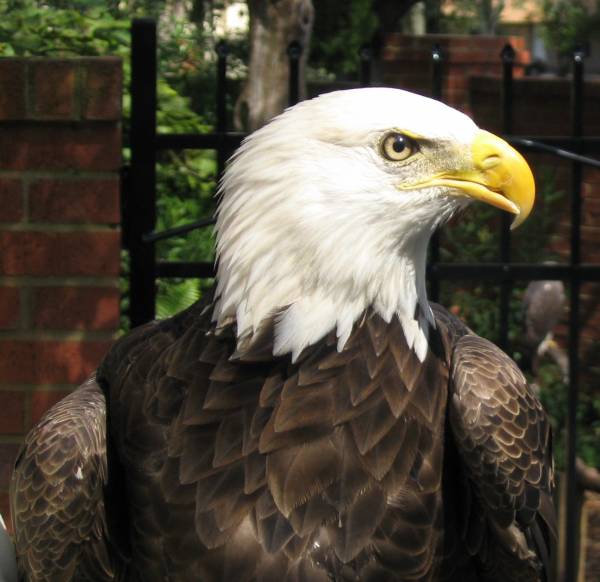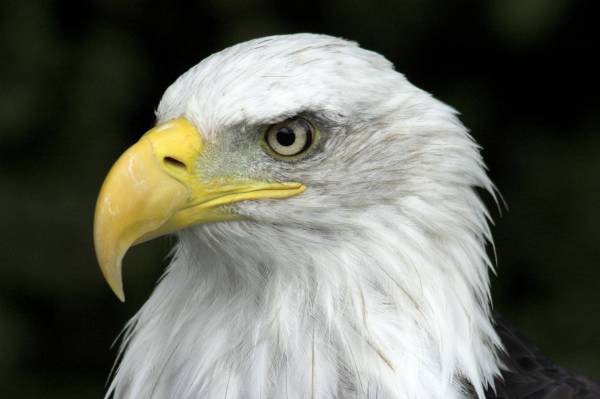Eagle
Scientific classification
Kingdom: Animalia
Phylum: Chordata
Class: Aves
Order: Falconiformes
Family: Accipitridae
The modern English name of the bird is derived from the Latin term aquila by way of the French Aigle. The Latin aquila may derive from the word aquilus, meaning dark-colored, swarthy, or blackish, as a description of the eagle's plumage; or from Aquilo, the Latin version of Greek Boreas, or north wind.
Old English used the term Earn, related to Scandinavia's �rn. The etymology of this word is related to Greek ornos, literally meaning "bird". In this sense, the Eagle is the Bird with a capital B.
Eagles are large birds of prey which inhabit mainly the Old World, with only two species (the Bald Eagle and Golden Eagle) found in North America north of Mexico, a few in Middle and South America, two (the White-bellied Sea Eagle and Wedge-tailed Eagle) in Australia, and the Philippine Eagle in the Philippines. They are members of the bird order Falconiformes (or Accipitriformes, according to alternative classification schemes), family Accipitridae, and belong to several genera which are not necessarily closely related to each other.
Eagles are differentiated from other broad-winged birds of prey mainly by their larger size, more powerful build, and heavier head and bill. Even the smallest eagles, like the Booted Eagle (which is comparable in size to a Common Buzzard or Red-tailed Hawk), have relatively longer and more evenly broad wings, and more direct, faster flight. Most eagles are larger than any other raptors apart from the vultures.
Like all birds of prey, eagles have very large powerful hooked beaks for tearing flesh from their prey, strong legs, and powerful talons. They also have extremely keen eyesight to enable them to spot potential prey from a very long distance. This keen eyesight is primarily contributed by their extremely large pupils which cause minimal diffraction (scattering) of the incoming light.
In Britain before 1678, Eagle referred specifically to the Golden Eagle, the other native species, the White-tailed Eagle, being known as the Erne. The modern name "Golden Eagle" for Aquila chrysaetos was introduced by the naturalist John Ray.
Eagles build their nests, which are sometimes called eyries in tall trees or on high cliffs.
Eagles are sometimes used in falconry. They appear prominently in myth and literature. In the Old World, such references are commonly to the Golden Eagle (or possibly closely related species found in warm climates).
Species FAMILY ACCIPITRIDAE
* Subfamily Buteoninae - hawks (buzzards), true eagles and sea-eagles o Genus Geranoaetus
+ Black-chested Buzzard-eagle, Geranoaetus melanoleucus o Genus Harpyhaliaetus
+ Crowned Solitary Eagle, Harpyhaliaetus coronatus
+ Solitary Eagle, H. solitarius o Genus Morphnus
+ Crested Eagle, Morphnus guianensis The powerful Harpy Eagle can easily grab a monkey weighing 5 kg and fly away with it. The powerful Harpy Eagle can easily grab a monkey weighing 5 kg and fly away with it.
* o Genus Harpia
+ Harpy Eagle, Harpia harpyja o Genus Pithecophaga
+ Philippine Eagle, Pithecophaga jefferyi o Genus Harpyopsis
+ New Guinea Eagle, Harpyopsis novaeguineae o Genus Oroaetus
+ Black-and-chestnut Eagle, Oroaetus isidori o Genus Spizastur
+ Black-and-white Hawk-eagle, Spizastur melanoleucus o Genus Spizaetus
+ Cassin's Hawk-eagle, Spizaetus africanus
+ Changeable Hawk-eagle, S. cirrhatus
+ Mountain Hawk-eagle, S. nipalensis
+ Blyth's Hawk-eagle, S. alboniger
+ Javan Hawk-eagle, S. bartelsi
+ Sulawesi Hawk-eagle, S. lanceolatus
+ Philippine Hawk-eagle, S. philippensis
+ Wallace's Hawk-eagle, S. nanus
+ Black Hawk-eagle, S. tyrannus
+ Ornate Hawk-eagle, S. ornatus o Genus Lophaetus
+ Long-crested Eagle, Lophaetus occipitalis - possibly belongs in Ictinaetus o Genus Stephanoaetus
+ Crowned Hawk-eagle, Stephanoaetus coronatus o Genus Polemaetus
+ Martial Eagle, Polemaetus bellicosus o Genus Hieraaetus
+ Ayres' Hawk-eagle, Hieraaetus ayresii
+ Rufous-bellied Eagle, H. kienerii
+ African Hawk Eagle, H. spilogaster A Steppe Eagle in Lahore Zoo. A Steppe Eagle in Lahore Zoo.
* o Genus Harpagornis (extinct)
+ Haast's Eagle, Harpagornis moorei - possibly belongs in either Hieraaetus or Aquila[2] o Genus Aquila
+ Bonelli's Eagle, Aquila fasciata - formerly Hieraaetus fasciatus
+ Booted Eagle, A. pennata - formerly Hieraaetus pennatus
+ Little Eagle, A. morphnoides
+ Golden Eagle, A. chrysaetos
+ Eastern Imperial Eagle, A. heliaca
+ Spanish Imperial Eagle A. adalberti
+ Steppe Eagle, A. nipalensis
+ Tawny Eagle, A. rapax
+ Greater Spotted Eagle, A. clanga - to be moved to Lophaetus or Ictinaetus
+ Lesser Spotted Eagle, A. pomarina - to be moved to Lophaetus or Ictinaetus
+ Indian Spotted Eagle, A. hastata - to be moved to Lophaetus or Ictinaetus
+ Verreaux's Eagle, A. verreauxii
+ Gurney's Eagle, A. gurneyi
+ Wahlberg's Eagle, A. wahlbergi
+ Wedge-tailed Eagle, A. audax o Genus Ictinaetus
+ Black Eagle, Ictinaetus malayensis o Genus Haliaeetus
+ White-tailed Eagle, Haliaeetus albicilla
+ Bald Eagle, H. leucocephalus
+ Steller's Sea-eagle, H. pelagicus
+ African Fish-eagle, H. vocifer
+ White-bellied Sea-eagle, H. leucogaster
+ Sanford's Fish-eagle, H. sanfordi
+ Madagascar Fish-eagle, H. vociferoides
+ Pallas' Sea-eagle, H. leucoryphus o Genus Ichthyophaga
+ Lesser Fish-eagle, Ichthyophaga humilis
+ Grey-headed Fish-eagle, I. ichthyaetus A dark individual of the Short-toed Eagle. A dark individual of the Short-toed Eagle.
* Subfamily Circaetinae: snake-eagles o Genus Terathopius
+ Bateleur, Terathopius ecaudatus o Genus Circaetus
+ Short-toed Eagle, Circaetus gallicus
+ Black-chested Snake-eagle, C. pectoralis
+ Brown Snake-eagle, C. cinereus
+ Fasciated Snake-eagle, C. fasciolatus
+ Banded Snake-eagle, C. cinerascens o Genus Spilornis
+ Crested Serpent-eagle, Spilornis cheela
+ Nicobar Serpent-eagle, S. minimus
+ Mountain Serpent-eagle,S. kinabaluensis
+ Sulawesi Serpent-eagle, S. rufipectus
+ Philippine Serpent-eagle, S. holospilus
+ Andaman Serpent-eagle, S. elgini o Genus Eutriorchis
+ Madagascar Serpent-eagle, Eutriorchis astur
Eagles as national symbols
The eagle has been used by many nations as a national symbol, depicting power, beauty and independence.
* Arabic world. Many Arabic states and organisations use eagles as symbols, e.g. the PLO.
* Czech Republic. The Czech Republic integrates three historical parts: Bohemia (with a double-tailed lion in the emblem), Moravia and Silesia (both with female eagles in their emblems - red-and-white chequered and black).
* Hellenistic Egypt. The Ptolemaic rulers of Egypt used it as their seal.
* First French Empire. Napoleon Bonaparte used the Roman Golden Eagle as the symbol of his new French empire.
* Ghana. Two eagles are part of the coat of arms of Ghana.
* Mexico. The bird on the Mexican coat of arms and flag is a Golden Eagle.
* Moldova. An eagle is part of the coat of arms and flag of Moldova.
* The Philippines. The endangered Philippine Eagle is the national bird of the Philippines.
* Poland. A white eagle on a red field is the coat of arms of Poland.
* Romania. The eagle is also part of the coat of arms of Romania
* Rome. The Romans used it on the standards of their armies. From this derives: o The late Byzantine Empire) chose a two-headed golden eagle as its symbol. It is popularly that one head symbolised ancient Rome, and the other head symbolised "new Rome" at Constantinople. From this derives: + Albania. The two-headed eagle is the emblem of "Shqip�ria" or Land of the Eagles, which is known in English as Albania (see The Tale of the Eagle for the legendary origin of the name) + Russian Empire. After the fall of Constantinople, the Russian Empire took the two-headed eagle as its own symbol. o Charlemagne and Holy Roman Empire. After his crowning as the new Roman Emperor, Charlemagne adopted the ancient Roman eagle as his own symbol. The Holy Roman Empire born of his kingdom took the eagle, but the Habsburgs replaced the golden eagle by an imperial eagle. From this derives: + Austria. The Austrian Empire had a two-headed eagle as its symbol. After the abolition of Austria-Hungary, Austria took as its symbol a one-headed eagle in the modern coat of arms of Austria. + Germany and Prussia. Prussia, and later Germany have used a black eagle as their national symbol. + Spain. The "Catholic Kings", Isabella and Ferdinand, used the Golden Eagle as a part of the royal shield. The eagle was on the Spanish shield until 1978.
* Serbia/Montenegro. The Two-headed eagle is the emblem of Serbia, Montenegro, and Serbia and Montenegro.
* The Seljuk Turks and Ottoman Turks used a double-headed eagle as coats-of-arms.
* USA. The United States has adopted the North American Bald Eagle as its national emblem. Although the Golden Eagle is found in North America, U.S. references to an unspecified "eagle" are often to the Bald Eagle, especially in an emblematic context. However, a few U.S. coins have shown the Golden Eagle (recognizable because the feathering on its legs extends to the base of the toes);[3] [4] this error is the cause of the expression "illegal eagle".
Eagles as religious objects
In Jewish tradition the eagle is a symbol of greatness, and leaders such as the medieval sage Maimonides and the Lubavitcher Rebbe, Rabbi Menachem M. Schneerson, have been referred to by their peers and students as "The Great Eagle". The Torah compares God Himself to an eagle in Deuteronomy, 32.11-12. "As an eagle awakens its nest, hovering over its fledglings, it spreads its wings, taking them and carrying them on its pinions. [So] the Lord guided them [the Israelites] alone, and there was no alien deity with Him."
Eagle lecterns are very common in Christian churches and cathedrals. The eagle is the symbol used to depict John the Apostle, whose writing most clearly witnesses the light and divinity of Christ. In art, John, as the presumed author of the Gospel, is often depicted with an eagle, which symbolizes the height he rose in the first chapter of his gospel.
The eagle is a sacred bird in some cultures and the feathers of the eagle are central to many religious and spiritual customs, especially amongst Native Americans. Native Americans revere eagles as sacred religious objects and the feathers and parts of Bald and Golden Eagles are often compared to the Bible and crucifix. Eagle feathers are often used in various ceremonies and are used to honor noteworthy achievements and qualities such as exceptional leadership and bravery.
Despite modern and historic Native American practices of giving eagle feathers to non-Native Americans and Native American members of other tribes who have been deemed worthy, current United States eagle feather law stipulates that only individuals of certifiable Native American ancestry enrolled in a federally recognized tribe are legally authorized to obtain eagle feathers for religious or spiritual use.
Major new research into eagle taxonomy suggests that the important genera Aquila and Hieraaetus are not composed of nearest relatives, and it is likely that a reclassification of these genera will soon take place, with some species being moved to Lophaetus or Ictinaetus.
* Bonelli's Eagle, the Booted Eagle and the Little Eagle have been moved from Hieraaetus to Aquila.
* Either the Greater Spotted Eagle and Lesser Spotted Eagle should move from Aquila to join the Long-crested Eagle in Lophaetus, or, perhaps better, all three of these species should move to Ictinaetus with the Black Eagle.
* The Steppe Eagle and Tawny Eagle, once thought to be conspecific, are not even each other's nearest relatives. |



